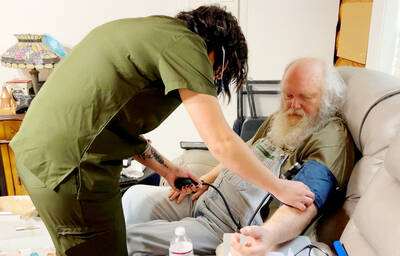In these hallowed halls, Indiana Jones almost seems out of place.
A banner with a two-dimensional cutout of the swashbuckling archaeologist swings through the lobby of Industrial Light and Magic, where life-size replicas of Darth Vader and Bobba Fett from `Star Wars stand guard.
The home of George Lucas’ visual effects company is a high-tech temple to everything from the dinosaurs in Jurassic Park to the talking robots in Transformers. But Indy cannot take credit for the digital wizardry for which ILM has become famous over the last couple of decades.
Not yet, anyway. That is because he has not been around for 19 years, a time in which special effects has mostly migrated from sound stage to server.
The first three Indy films were gritty, sweaty and tactile affairs, largely because everything on-screen physically existed somewhere. Not so with Indiana Jones and the Kingdom of the Crystal Skull — though that was almost the case.
When first approaching the latest Indy, director Steven Spielberg considered dusting off his old-school approach.
“He thought maybe we should just go back to the way we did things before, like matte paintings on glass and things like that,” visual effects supervisor Pablo Helman said. “We entertained that idea for a little bit, but we realized we could serve the story better by using our digital tools.”
That decision ultimately led to a filmmaking innovation that brings the random reactions of a virtual world to the big screen, giving more control to ILM’s computers than ever before.
To the children romping outside at ILM’s in-house daycare located just past the lobby, the notion of a digital “environment” being responsible for much of what is on-screen will probably seem quaint someday.
But to the adult audiences who have glimpsed the latest Indy escapade, it is a big part of the reason this one looks so different from Jones’ last crusade.
Helman, who previously worked with Spielberg on Munich and War of the Worlds, was tasked with creating realistic-yet-fantastic environments and creatures for Crystal Skull, which finds Jones traipsing from New England to New Mexico, Peru and the Amazon. Working on the Indy franchise for the first time was a daunting task for the low-key effects guru.
“It’s horrifying to work on a movie that has this many fans, but at the same time, it’s an opportunity and a challenge,” Helman said less than a week before its release. “I think we were all very, very respectful of the other three movies but also to the fans. All the effects work that we’re doing are completely reality-based.”
That is if your reality includes a blooming atomic mushroom cloud, seemingly endless Area 51 warehouse, vicious monkey army, the City of Gold, thousands of man-eating ants and sundry otherworldly things.
All those locales and critters were created by Helman and his ILM team for Crystal Skull, making up the film’s 450 effects shots — not quite as many as the 600-plus in Transformers, but more than you might expect from a flesh-and-blood character from the 1950s.
About 300 artists and editors worked for eight months in post-production on a high-tech computer network at ILM’s offices inside the Presidio of San Francisco, a long way from the Raiders of the Lost Ark and Temple of Doom days, when Indiana Jones special effects mostly consisted of miniature sets and a few blue-screen mash-ups.
“The only reason why they weren’t using computer-generated effects back then is because they weren’t invented yet, but they were using the most up-to-date technology at the time,” said Helman, who finished his work on Crystal Skull in mid-April.
“So it only follows that we would do the same thing now.”
In the film’s biggest action sequence, Jones and company battle Russian soldiers and play hot potato with the “Crystal Skull”, all while careening through a fertile Amazonian jungle riding atop military vehicles. When not dodging trees and palm fronds, the jeeps plow through enough vegetation to give an arborist heart palpitations.
“The script calls for a virgin jungle, but there’s not one we could safely run four vehicles through,” said Helman. “We could’ve approached it in a more modern way on a big stage with a blue screen, but that’s not the way we did it. We basically shot it the same way we would’ve shot it 20 years ago.”
Spielberg filmed the pursuit scene on dirt roads in a more sparse jungle in Hawaii. Helman traveled to Argentina, where he was born, and Brazil to capture images that would be used to craft the junglescape, including a looming cliff where part of the chase takes place.
At the ILM offices, Helman and his team meshed the Hawaiian footage with the Brazilian and Argentine imagery, adding huge swathes of flora using a new digital-effects technique. The result is a fictitious jungle, one with its own look, layout and laws of physics, that only exists inside the computers at ILM.
“The whole film for us has been really big on particle simulation, which is creating an environment inside of a computer and telling the computer the rules of the world,” said Helman, who also worked on two of the Star Wars films. “You give the computer this gravity, this mass, this amount of wind and see what happens.”
That means instead of crafting movement for every vine and leaf that Indy and company hammer through, visual effects artists were able to drag and drop virtual vegetation programmed to react to the vehicles’ presence and actors’ movements. It is an application that has long become de rigueur for video games, and come full circle to the big screen.
Even though they were going for something organic, Helman said the filmmakers took some liberties with the laws of physics — more gravity, more mass, more wind — to “make it more cinematic.”
The result is a highly detailed chase scene that is far different from Indy’s landmark escape from a giant rolling ball of a boulder in Raiders of the Lost Ark. And it is just one of the many effects Helman and his crew created for the film.
However, there is one thing that he insists did not receive a computer-generated makeover this time around: Indy’s signature accessories.
“We did not generate whips or hats,” he said, cracking a smile.

Oct. 27 to Nov. 2 Over a breakfast of soymilk and fried dough costing less than NT$400, seven officials and engineers agreed on a NT$400 million plan — unaware that it would mark the beginning of Taiwan’s semiconductor empire. It was a cold February morning in 1974. Gathered at the unassuming shop were Economics minister Sun Yun-hsuan (孫運璿), director-general of Transportation and Communications Kao Yu-shu (高玉樹), Industrial Technology Research Institute (ITRI) president Wang Chao-chen (王兆振), Telecommunications Laboratories director Kang Pao-huang (康寶煌), Executive Yuan secretary-general Fei Hua (費驊), director-general of Telecommunications Fang Hsien-chi (方賢齊) and Radio Corporation of America (RCA) Laboratories director Pan

President William Lai (賴清德) has championed Taiwan as an “AI Island” — an artificial intelligence (AI) hub powering the global tech economy. But without major shifts in talent, funding and strategic direction, this vision risks becoming a static fortress: indispensable, yet immobile and vulnerable. It’s time to reframe Taiwan’s ambition. Time to move from a resource-rich AI island to an AI Armada. Why change metaphors? Because choosing the right metaphor shapes both understanding and strategy. The “AI Island” frames our national ambition as a static fortress that, while valuable, is still vulnerable and reactive. Shifting our metaphor to an “AI Armada”

The older you get, and the more obsessed with your health, the more it feels as if life comes down to numbers: how many more years you can expect; your lean body mass; your percentage of visceral fat; how dense your bones are; how many kilos you can squat; how long you can deadhang; how often you still do it; your levels of LDL and HDL cholesterol; your resting heart rate; your overnight blood oxygen level; how quickly you can run; how many steps you do in a day; how many hours you sleep; how fast you are shrinking; how

When Taiwan was battered by storms this summer, the only crumb of comfort I could take was knowing that some advice I’d drafted several weeks earlier had been correct. Regarding the Southern Cross-Island Highway (南橫公路), a spectacular high-elevation route connecting Taiwan’s southwest with the country’s southeast, I’d written: “The precarious existence of this road cannot be overstated; those hoping to drive or ride all the way across should have a backup plan.” As this article was going to press, the middle section of the highway, between Meishankou (梅山口) in Kaohsiung and Siangyang (向陽) in Taitung County, was still closed to outsiders